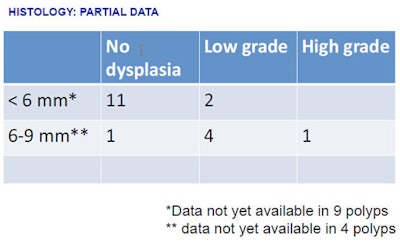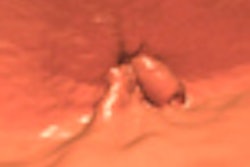
CHICAGO - A preliminary study from Italy adds weight to the argument that two- to three-year surveillance of 6- to 9-mm polyps doesn't unduly increase the risk of colorectal cancers. Diminutive polyps grow faster but present less cause for concern.
"What we know now about the adenoma carcinoma sequence is that it takes about five years to have an adenoma, then about two years to have a carcinoma in situ, and then about three years to have an invasive carcinoma, said Dr. Emanuele Neri from the University of Pisa in Italy. "What we don't know is what polyps do -- we know that some grow, but some also shrink" over time, he said.
Neri presented his study on Sunday at the RSNA meeting in Chicago.
Of particular interest are so-called intermediate (6-9 mm) colorectal polyps, for which some providers of virtual colonoscopy (also known as CT colonography or CTC) have started giving patients a choice: immediate polypectomy, or two- to three-year surveillance of one or two such lesions, followed by repeat CTC to determine if they have grown to the 10-mm threshold (considered clinically significant), at which colonoscopy and polypectomy are universally recommended.
Previous research by Dr. David Kim and colleagues from the University of Wisconsin in Madison, and other groups, suggests that surveillance is safe, but the practice remains controversial.
In their study, Neri and his team aimed to determine the progression of 6- to 9-mm (C-RADS2) as well as diminutive polyps in a large cohort.
Among 1,057 virtual colonoscopy studies performed over three years, 189 (18%) were classified as C-RADS2, with recommendation for repeat CTC within three years.
"At the time of this report, 20 out of 189 [10%] patients have been followed-up with low-dose prone and supine CTC," Neri said. To date, 32 colonic polyps (22 smaller than 6 mm and 10 6- to 9-mm lesions) have been analyzed.
The researchers measured polyp size by axial and multiplanar reconstructions (MPR) in prone and supine views. Comparisons between size at baseline and follow-up CTC were made on the same view and expressed as the mean, plus or minus the standard deviation.
"We measured the polyp with the sagittal view, the axial view, the coronal view, and, if necessary, the oblique view to find the maximum diameter as suggested ..." he said. "We found that polyp size increased in about one-third of cases compared with the baseline measurement."
Polyp size at baseline and follow-up
|
||||||||||||||||
| Friedman rank test *Statistically significant (p < 0.05) Results at two- to three-year follow-up show that only diminutive polyps grew significantly. Tables courtesy of Dr. Emanuele Neri. |
Histology: Partial data
|
||||||||||||
| *Data not yet available in 9 polyps **Data not yet available in 4 polyps Partial histological results show that the presence of advanced dysplasia is rare at short-term follow-up. |
Polyps size increased in 11 of 32 cases (34.4%), 10 of which were smaller than 6 mm (10/22, 45.4%). Overall polyp size was not significantly different at baseline and follow-up (4.14 ± 4.91 mm versus 4.52 ± 4.73 mm). The diminutive polyps smaller than 6 mm had grown significantly at follow-up (3.20 ± 3.25 mm versus 1.52 ± 2.20 mm, respectively; p=0.0188, Friedman rank test). Polyps in the 6- to 9-mm category were not significantly different at baseline and follow-up (7.71 ± 1.25 mm versus 6.14 ± 4.34 mm, p = 0.25).
"The change was significant in the case of hyperplastic polyps with a maximum diameter, but not statistically significant in intermediate polyps," he said. Histological results available for 19 polyps 10 mm or smaller show only one case of high-grade dysplasia, in a 6- to 9-mm lesion examined 28 months after baseline.
The small sample size and lack of histology for all polyps are major limitations of the study, Neri added.
"The mean polyp size variation was not statistically significant for medium-sized polyps," he said. "These preliminary results suggest that polyp follow-up in a maximum three-year period does not increase the risk of developing colorectal cancer."
Session moderator Dr. Judy Yee asked Neri about the difficulty of accurately measuring polyps in 2D versus 3D or volumetric methods available on newer software systems. The readers, accustomed to primary 2D interpretation, "prefer to measure what they can directly see," Neri said. In any case, careful multiplanar measurement including oblique view ensures the accuracy of the method, he said.
By Eric Barnes
AuntMinnie.com staff writer
November 30, 2009
Related Reading
New ACR guidelines overhaul VC practice, training standards, November 27, 2009
Colon cancer screening every 10 years OK for some at risk, July 22, 2009
VC is cost-effective for screening; tiny polyps can be ignored, July 15, 2009
American Cancer Society recognizes virtual colonoscopy screening benefit, March 5, 2008
Copyright © 2009 AuntMinnie.com




















